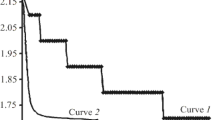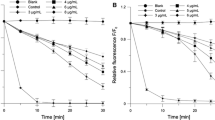The formation of chelate complexes of dihydroqercetin (DHQ) with zinc and chromium asparaginates in aqueous solution is established and their interaction with a lecithin monolayer is estimated. On the basis of analysis of the surface pressure-molecular area isotherms, it is concluded that an increase in the molecular area from 0.54 to 0.80–0.90 nm 2 is indicative of the immobilization of DHQ complexes in the lecithin monolayer. It is shown that the concentration of the initial products of lipid peroxidacion-diene and triene conjugates-decreases to 24 % and 41 %, respectively, and that of the final products (Schiff bases) in the blood of patients treated by Oftalvit (containing DHQ and metal asparaginates) decreases to 46 % in comparison to values in the control groups.
Similar content being viewed by others
References
A. V. Skal'nyh and I. A. Rudakov, Bioelements in Medicine [in Russian], Mir, Moscow (2004).
V. K. Kolkhir, N. A. Tyukavkina, V. A. Bykov, et al., Khim.-Farm. Zh., 2, No. 9, 61 (1995).
Yu. O. Teselkin, B. A. Zhambalova, I. V. Babenkova, et al., Biofizika, 41, No. 3, (1996).
E. J. Middleton, C. Kandaswami, and T. C. Theoharides, Farmacol. Rev., 52, 673–751 (2000).
J. E. Brown, H. Khodr, R. C. Hider, and C. A. Rice-Evans, Biochem., 330, 1173–1178 (1998).
E. Balogh-Hergovich, J. Kaizer, G. Speier, et al., Chem. Soc. Dalton Trans., 3847–3854 (1999).
S. A. Van Acker, M. J. de Groof, D.-J. van den Berg, et al., Chem. Res. Toxicol., 9, 1305–1312 (1996).
A. Arora, T. M. Byrem, M. G. Nair, and G. M. Strasbourg, Arch. Biochem. Biophys., 373, 102–109 (2000).
N. B. Mel'nikova, A. A. Volkov, M. V. Kulikov, and I. V. Gulyaev, Izv. VUZov. Ser. Khim. i Khim. Tekhnol., 47, No. 9, 22–26 04
A. P. Es'kin, V. A. Levandskii, and N. I. Polezhaeva, Khim. Rastit. Syr'ya, 3, 41–46 (1998).
N. B. Mel'nikova, I. D. Ioffe, and L. A. Tsareva, Khim. Prirod. Soedin., 1, 48–56 (2002).
F. Cotton and J. Wilkinson, Contemporary Inorganic Chemistry [Russian translation], Chapter 3: Chemistry of the Transition Elements, Mir, Moscow (1969).
D. Metodiewa A. K. Jaiswal, N. Cenas, et al., Free Rad. Biol. Med., 26, 107–116 (1999).
N. B. Mel'nikova and I. D. Ioffe, Khim. Rastit. Syr'ya, 4, 25–33 (2001).
J. B. Park and M. Levine, Nutrients, 130, 1297–1302 (2000).
E. F. Ivanenko, The Biochemistry of Vitamins [in Russian], Vishcha Shkola, Kiev (1970).
V. F. Gromovaya, G. S. Shapoval, I. E. Mironyuk, and V. I. Piven', Khim.-Farm. Zh., No. 7, 3–5 (1996).
In: Biochemical, Pharmacological, and Structure-Activity Relationships, V. Cody, E. J. Middleton, and J. B. Harborne (Eds.), Alan R. Liss Inc., New York (1986), pp. 411–424.5)
Author information
Authors and Affiliations
Corresponding author
Additional information
Translated from Khimiko-Farmatsevticheskii Zhurnal, Vol. 42, No. 10, pp. 14–20, October, 2008.
Rights and permissions
About this article
Cite this article
Donracheva, L.G., Mel’nikova, N.B., Pegova, I.A. et al. Complexes of dihydroquercetin with chromium (III) and zinc (II) asparaginates in water and their effects on the state of lecithin membranes. Pharm Chem J 42, 564–570 (2008). https://doi.org/10.1007/s11094-009-0186-2
Received:
Published:
Issue Date:
DOI: https://doi.org/10.1007/s11094-009-0186-2




